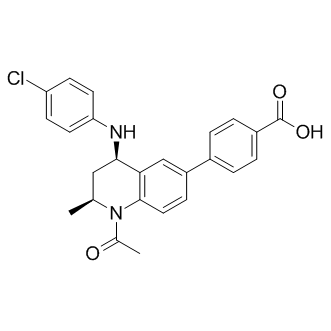| DC70466 |
GSK549
|
GSK549 (GSK-549) is a potent, highly selective, BD2 domain-selective BET inhibitor with pIC50 of 7.8 (BRD4 BD2), 1150-fold selectivity over BD1. |
| DC11261 |
ZL0420
|
ZL0420 is a potent, highly selective BRD4 inhibitor with IC50 of 27 and 32 nM for BRD4-BD1 and BRD4-BD2, respectively. |
| DC8261 |
(-)-JQ-1
|
The (-)-JQ1 stereoisomer has no appreciable affinity to BET bromodomains,it is the negative control of +JQ-1. |
| DC8320 |
RVX-208
|
RVX-208(RVX 000222) is a small molecule that increases apolipoprotein A-I and high-density lipoprotein cholesterol in vitro and in vivo; is a BET bromodomain antagonist. |
| DC10786 |
PLX51107
|
PLX51107 is a novel BET inhibitor with a unique binding mode in the acetylated lysine binding pocket of BRD4 that differentiates it from other compounds under investigation. |
| DC8291 |
PFI-4
|
PFI-4 is a potent and selective BRPF1 bromodomain inhibitor (IC50 = 80 nM). |
| DC7649 |
PFI-3
|
PFI-3 is a novel potent, selective and cell permeable inhibitor of SMARCA4 and PB1(5) bromodomains with IC50 ~ 89 nM and 48 nM respectively. |
| DC9305 |
PF-CBP1(PF-06670910) hydrochloride
|
PF-CBP1 is potent and highly-selective inhibitor of the bromodomain of CREB binding protein (CBP BRD) that down regulates targets of CBP in macrophages primary neurons. |
| DC7850 |
OF-1
|
OF-1 is a potent inhibitor of BRPF1B and BRPF2 bromodomain with Kd of 100 nM and 500 nM, respectively. |
| DC9758 |
NI-57
|
NI-57 is a potent inhibitor of the bromodomains of BRPF proteins that binds to BRPF1B, BRPF2, and BRPF3 with Kd values of 31, 108, and 408 nM, respectively, as determined by isothermal titration calorimetry. |






















